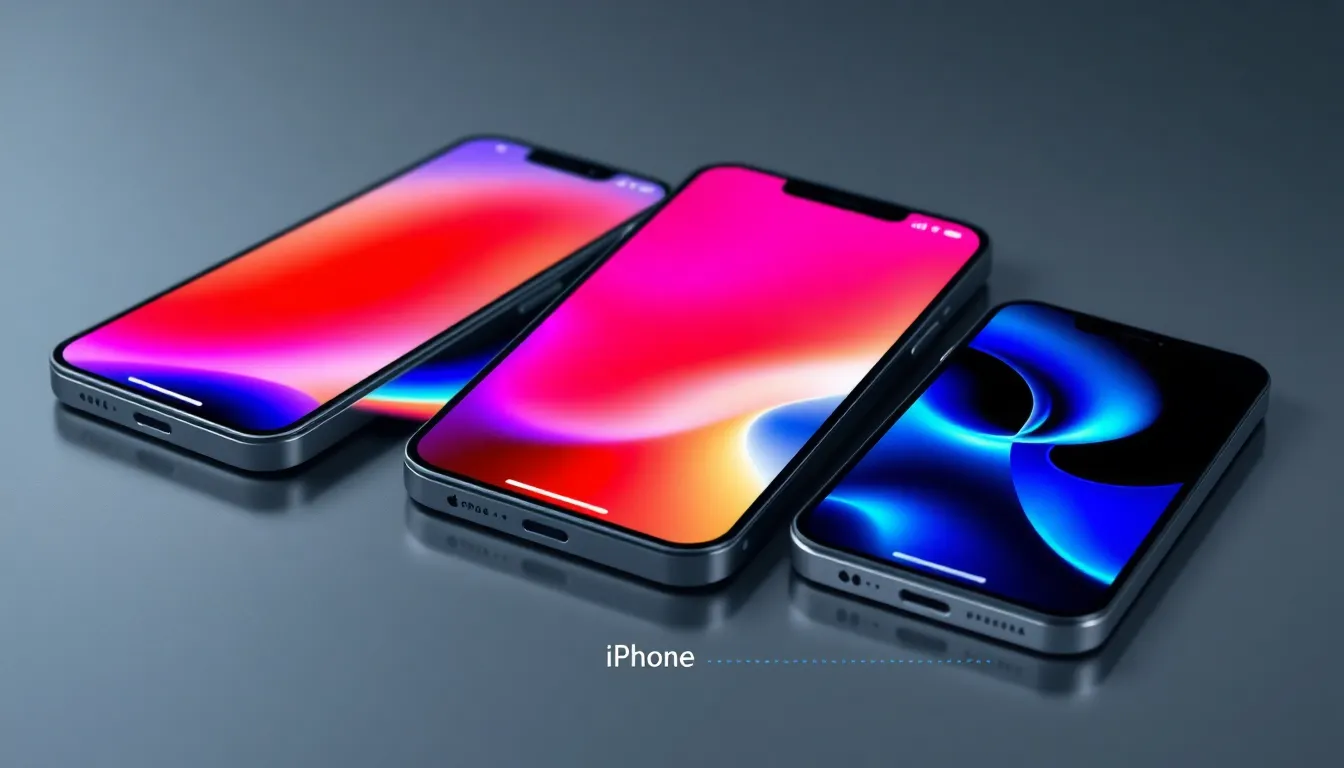Ever wondered just how many tiny dots make up that stunning screen on your iPhone? Spoiler alert: it’s a lot! Understanding the pixel width of an iPhone isn’t just for tech geeks; it’s for anyone who appreciates a crisp image and vibrant colors. Whether you’re scrolling through social media or binge-watching your favorite series, those pixels play a crucial role in your viewing experience.
Table of Contents
ToggleOverview of iPhone Display Specifications
iPhone display specifications include various pixel widths depending on the model. The latest models feature distinct pixel dimensions, enhancing user experience. For instance, the iPhone 14 Pro Max showcases a pixel width of 2796 pixels, delivering stunning clarity for images and videos.
Another example lies in the iPhone 13, which presents a pixel width of 2532 pixels. This resolution provides excellent quality for everyday tasks like browsing and gaming. Similarly, the iPhone SE packs a pixel width of 1334 pixels, ensuring efficient viewing on a more compact screen.
Apple prioritizes pixel density, measured in pixels per inch (PPI), to create vibrant displays. The iPhone 14 Pro Max achieves 460 PPI, optimizing image sharpness and detail. In contrast, the iPhone SE reaches 326 PPI, balancing quality and affordability.
Understanding specifications helps users select the right iPhone according to their needs. Users interested in photography or videography benefit from higher pixel widths that yield clearer images. For casual users, lower pixel widths might suffice, offering good quality without premium costs.
In addition to pixel width, display technology plays a role in overall performance. OLED screens provide deeper blacks and richer colors compared to LCD screens. Ultimately, these specifications collectively enhance the iPhone experience across different activities, from movies to messaging.
Understanding Pixel Width

Pixel width refers to the number of pixels that span the width of a device’s display. Each iPhone model features unique pixel widths, impacting visual clarity and detail.
Definition of Pixel Width
Pixel width is defined as the total count of individual pixels aligned horizontally across a display. This measurement provides insight into a device’s ability to showcase sharp images and text. The relationship between pixel width and overall resolution becomes significant when examining various iPhone models. For instance, the iPhone 14 Pro Max’s pixel width stands at 2796 pixels, while the iPhone 13 features 2532 pixels and the iPhone SE offers 1334 pixels. Higher pixel counts contribute to improved visual quality, making pixel width a critical specification in understanding display performance.
Importance of Pixel Width in Displays
Pixel width in displays directly influences viewing experiences. A higher pixel width enhances image precision, essential for activities like photography or video streaming. Users benefit from clearer images, whether they’re scrolling through social media or watching films. Different iPhone models cater to varying needs, ensuring that users engaged in detailed tasks see improvements with larger pixel widths. Moreover, pixel density, measured in pixels per inch, complements pixel width by providing context on clarity. For example, the iPhone 14 Pro Max delivers an impressive 460 PPI, whereas the iPhone SE’s PPI measures at 326, illustrating how pixel width contributes to the overall display quality and user satisfaction.
Pixel Width of Different iPhone Models
Pixel width plays a critical role in iPhone displays, affecting image quality and user experience differently across various series.
iPhone 13 Series
The iPhone 13 series showcases impressive pixel widths. The iPhone 13 features a pixel width of 2532 pixels, while both the 13 Mini and 13 Pro models boast similar specifications. Higher pixel counts in the iPhone 13 contribute to sharper images, enhancing overall viewing pleasure. Users enjoy vibrant colors and detailed visuals, making the iPhone 13 series a solid choice for photography and media consumption.
iPhone 14 Series
In the iPhone 14 series, advancements continue with the iPhone 14 Pro Max offering a pixel width of 2796 pixels. This model stands out for its high pixel density of 460 PPI, ensuring optimal sharpness. Other models like the iPhone 14 and 14 Plus provide excellent quality, with pixel widths around 2556 pixels. Enhanced visuals cater to users who appreciate an immersive screen experience, whether watching videos or engaging in social media.
iPhone 15 Series
The iPhone 15 series pushes boundaries further with improved pixel widths. Notably, the iPhone 15 and 15 Plus maintain a pixel width of 2556 pixels, ensuring superb image clarity. The iPhone 15 Pro Max leads with pixel dimensions contributing to an outstanding viewing experience that exceeds users’ expectations. Apple’s commitment to high pixel density across this series emphasizes its pursuit of exceptional display quality, boosting enjoyment for all types of media.
Factors Influencing Pixel Width
Pixel width results from various factors that enhance the viewing experience on iPhones. Understanding these elements helps comprehend discrepancies across different models.
Screen Size
Screen size significantly determines pixel width on iPhones. Larger screens often feature higher pixel counts, allowing for improved image clarity. For instance, the iPhone 14 Pro Max supports a pixel width of 2796 pixels, while the iPhone 13 provides a width of 2532 pixels. Compact models, like the iPhone SE, naturally have less pixel width at 1334 pixels. Each screen size aims to enhance user engagement, whether through browsing or media consumption.
Resolution
Resolution impacts pixel width as well. Higher resolutions lead to more pixels packed into the same screen area. The iPhone 14 series illustrates this principle, offering resolutions that result in significant pixel widths. The iPhone 14 Pro Max achieves a resolution that translates into 460 pixels per inch (PPI), ensuring sharp images. In comparison, the iPhone SE, despite its lower pixel width, maintains a respectable PPI of 326, demonstrating that resolution plays an essential role in overall display quality.
The pixel width of an iPhone significantly impacts the user experience. Higher pixel counts enhance image clarity and vibrancy making every interaction more enjoyable. As Apple continues to innovate with each new series the advancements in pixel width and density reflect their commitment to delivering top-notch display quality.
Understanding the pixel specifications helps users make informed choices when selecting an iPhone model. Whether for photography video streaming or everyday use the difference in pixel width can elevate the overall experience. With the latest models leading the way in display technology users can expect nothing less than exceptional visual performance.


